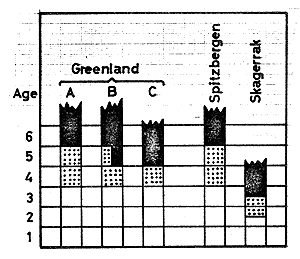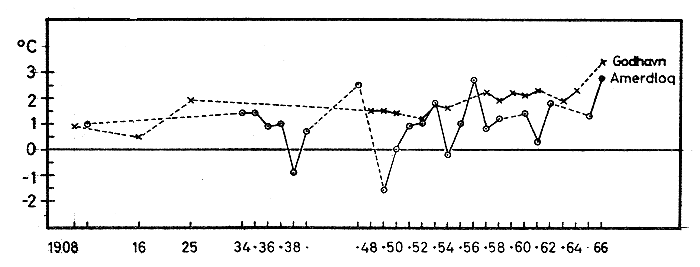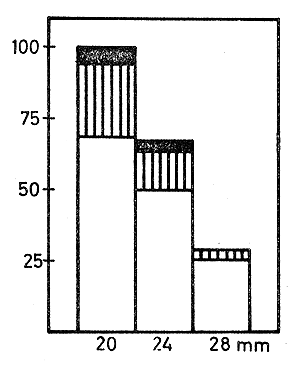by
ERIK SMIDT
Greenland Fisheries Investigations
Charlottenlund, Denmark
Abstract
The Greenland deep-sea prawn fishery started in 1935, and since the second world war it has become a very important industry with factories in many towns.
The prawns are widely distributed in Greenland waters, where they live on soft bottoms at depths mainly from 150 to 500 m and mainly at temperatures from 1 to 2°C. Their development and growth are relatively slow compared with stocks in more southern and warmer waters; change from males to females does not take place until they are 4 or 5 yr old. They play an important role in the food chain, and they seem to have a high natural mortality due to many fish predators.
Regular and irregular natural fluctuations in stock density (and trawl catches) have been observed, mostly caused by variations in water temperature. The inflow of warm bottom water from the Davis Strait helps to transport large quantities of prawns to the trawling grounds in the fjords and other inshore areas. Exceptionally cold water may destroy a local stock, as was the case in the fjords at Holsteinsborg in the winter of 1949.
Fluctuations in trawl catches are mostly due to natural variations in stock density, and overfishing does not seem to be a problem in Greenland at present. However, it is desirable to avoid undersized prawns in the catches, and the most effective measure would be to encourage trawling in deep water, where the big prawns predominate, while the undersized are most numerous in shallower water.
Pandalus borealis DES EAUX GROENLANDAISES: PECHE ET BIOLOGIE
Résumé
La pêche groënlandaise de la crevette nordique (Pandalus borealis), qui a commencé en 1935, est devenue depuis la Seconde Guerre mondiale une industrie très importante alimentant des usines dans de nombreuses villes.
Les crevettes sont largement réparties dans les eaux du Groënland, où elles habitent les fonds mous, à des profondeurs s'étageant surtout entre 150 et 500 mètres, et principalement dans des zones où la température va de 1 à 2°C. Leur développement et leur croissance sont lents par rapport à ceux des stocks occupant des eaux plus méridionales et plus chaudes; l'inversion du sexe (de mâle à femelle) ne se produit pas avant l'âge de 4 ou 5 ans. Ces animaux jouent un rôle important dans la chaîne alimentaire, et il semble que leur taux de mortalité naturelle soit élevé du fait du grand nombre de poissons prédateurs.
On a relevé des fluctuations naturelles régulières où irrégulières de la densité du stock (et des captures au chalut), provenant principalement de variations de la température de l'eau. L'afflux d'eaux chaudes de fond provenant du détroit de Davis contribue à transporter de grandes quantités de crevettes sur les fonds chalutables des fjords et d'autres zones côtières. L'arrivée d'eaux exceptionnellement froides peut détruire un stock local, comme cela s'est produit dans les fjords de la région d'Holsteinsborg durant l'hiver de 1949.
Les fluctuaciones relevées dans les captures au chalut proviennent surtout des variatons naturelles de la densité du stock, et la surexploitation ne paraît pas poser actuellement de problème au Groenland. Il convient toutefois d'éviter de pêcher des crevettes trop petites, et la mesure la plus efficace à cet effet consisterait à encourager le chalutage en eaux profondes, où prédominent les grosses crevettes, tandis que les petites se trouvent surtout sur les hauts-fonds.
Pandalus borealis EN AGUAS DE GROENLANDIA; SU PESQUERIA Y BIOLOGIA
Extracto
La pesquería del camarón Pandalus borealis en Groenlandia empezó en 1935, y desde la segunda Guerra Mundial se ha convertido en una industria muy importante que cuenta con fábricas en muchas ciudades.
Los camarones están ampliamente distribuidos en aguas de Groenlandia, en donde viven en fondos blandos a profundidades de 150 a 500 metros, principalmente, y a temperaturas de 1 a 2°C, sobre todo. Su desarrollo y crecimiento son relativamente lentos en comparación con las poblaciones de aguas más meridionales y más cálidas; el cambio de macho a hembra no se verifica hasta que tienen 4 ó 5 años. Desempeñan un importante papel en la cadena alimentaria y parece que sufren una gran mortalidad natural por la existencia de muchos predadores.
Se han observado fluctuaciones naturales, regulares e irregulares en la densidad de las poblaciones (y en las capturas realizadas al arrastre), causadas sobre todo por las variaciones en la temperatura del agua. La entrada de aguas templadas de fondo desde el estrecho de Davis ayuda a transportar grandes cantidades de camarones a las zonas donde se pesca al arrastre en los fiordos y en otros lugares próximos a la costa. Excepcionalmente el agua fría puede destruir poblaciones locales como ocurrió en los fiordos de Holsteinsborg en el invierno de 1949.
Las fluctuations de las capturas efectuadas al arrastre se deben, en su mayor parte, a variaciones naturales en la densidad de las poblaciones, y la pesca excesiva no parece que actualmente constituya un problema en Groenlandia. Sin embargo, conviene evitar la captura de camarones de poco tamaño, y para ello la medida más eficaz podría consistir en fomentar la pesca al arrastre en aguas profundas, en donde predominan los camarones grandes, mientras que los de tamaño pequeño son muy abundantes en aguas más superficiales.
The TJALFE Expedition, 1908 to 1909, established the occurrence of deep-sea prawns (Pandalus borealis Krøyer) in Greenland waters, and when the landings of halibut for a canning factory in the town Holsteinsborg failed soon after 1930, attempts were made to fish prawns instead of halibut for canning. After some experiments in 1934 a commercial prawn fishery was started in 1935, and it continued with success until the second world war. After the war systematic investigations were carried out by Greenland Fisheries Investigations under the leadership of Dr. Paul Hansen, and in a few years the most important prawn grounds in West Greenland waters were found. Very rich grounds were found in Disko Bay (1 to 3 in Fig. 1), where a fishery was started in 1949, and in 1950 a fishery was started in the fjords at Narssaq (10 and 11 in Fig. 1). In the following years the fishery constantly increased, especially in the years since 1960 (Fig. 2). Many grounds are now exploited (Fig. 1), but by far the biggest quantities are landed at Disko Bay, as seen in Fig. 2.
The prawn fishery is carried out from small cutters (mostly 20 to 25 RGT), and the gear used is a fine meshed otter trawl (mesh size 20 to 22 mm from knot to knot in cod-end). The prawns are landed fresh at the factories, where they are boiled, peeled, and then either canned or frozen. On the map (Fig.1) eight towns with factories are shown, and other smaller factories are established at three outposts. Six of the factories belong to the Royal Greenland Trading Company, and the others are private.
The deep-sea prawn is distributed along most of West Greenland and in the southern part of East Greenland. It lives on soft bottoms mainly at depths from 150 to 500 m, in all fjords and coastal waters with positive bottom temperatures (mostly 1 to 2°C), but in threshold fjords with cold bottom water (sub-zero) only a few small prawns are found, and P. borealis tends to be replaced by other prawn species, mostly Eualus macilentus.
In addition to the inshore waters of West Greenland, deep-sea prawns are also widely distributed and common in the deep parts of the Davis Strait. Since 1908, several Danish expeditions have made fishing experiments with fine meshed trawls in the Davis Strait, but the most numerous and extended were some prawn trawl experiments made by R/V DANA in July 1964 and 1966 in the deeps between the fishing banks and on the western slopes of the banks.
As the results of biological investigations have been published by Horsted and Smidt (1956, 1965) and by Smidt (1965), only the main features are given here, supplemented with results from more recent studies.
The Greenland deep-sea prawns are protandric hermaphrodites, as in other stocks, and they differ from the stocks in southern and warmer seas (e.g. the North Sea) in that no primary females have been observed in Greenland waters. Spawning takes place in July and August, and the females are ovigerous for about 9 mo until hatching takes place in April and May, while in Skagerak, for example, the ovigerous period lasts 5 mo. Development to mature male and female stages is also relatively slow in Greenland compared with more southern waters. In the Skagerak the prawns become males when 1½ yr old and females when 2½ yr old, while the Greenland prawns become males when 8 yr old and females when 4 or 5 yr old (Fig. 3). In the southwestern fjords with warm bottom water (normally over 1°C) sex change takes place when the prawns are 4 yr old, while in threshold fjords with colder water (under 1°C) and in Disko Bay, sex change takes place when they are 5 yr old. In some stocks some of the prawns change when 4 yr old and the remainder when 5 yr old.
Numerous trawling experiments over several years have shown that the small prawns predominate on shallower grounds, while big prawns are predominant at deeper water.

Fig. 1 Exploited trawling grounds (Nos. 1–13) in West Greenland. Grounds in Disko Bay shown in extension, other grounds only by an arrow. Towns with prawn industries underlined.

Fig. 2 Total annual landings (in metric tons) of deep-sea prawns in Greenland (full line) and annual landings from Disko Bay (broken line).
Observations made by Horsted (Horsted and Smidt, 1956:83–4; 1965:206) seem to show that the strength of year classes are of importance for the recruitment.
The deep-sea prawn must play an important role in the food chain. There seems to be a great natural mortality due to numerous predators, especially Greenland halibut (Reinhardtius hippoglossoides), halibut (Hippoglossus hippoglossus), cod (Gadus morhua), redfish (Sebastes marinus), several species of Lycodes, and other fish species (Smidt, 1965:101–2).
Fluctuations in the fishery due to fluctuations in the density of stocks have often been noticed, and in several cases it has been shown that variations in bottom temperatures were the cause of these fluctuations.
More or less regular variations in stock density, correlated with temperature variations, were observed by Horsted (Horsted and Smidt, 1956:79–82) in some fjords in the Julianehab district (10 and 11 in Fig. 1). Inflow of warm bottom water from the Davis Strait was followed by increasing trawl catches (kg/h trawled), and the migration of prawns was confirmed by tagging experiments.
The rich and extended prawn grounds found in 1964 by R/V DANA, in the Davis Strait, north of Store Hellefiske Bank, are regarded as an important recruitment reserve for the prawn grounds in Disko Bay. In July 1964, DANA trawled on average 180 kg of very big prawns per hour, mainly from depths of 400 to 500 m, but in 1966 it only got about 90 kg/h in the same area. It is remarkable that the commercial cutters in Disko Bay got unusually big catches of unusually big prawns in 1966, and that in the same year the deep-water temperatures were unusually high in the Davis Strait, in Disko Bay and in several fjords (see Fig. 4). It is therefore probable that large quantities of big prawns were transported into Disko Bay with the intrusion of warm bottom water from the Davis Strait.
In general, the extended resources of deep-sea prawns in the Davis Strait may thus be regarded as important reserves for the prawn stocks in West Greenland fjords and inshore waters, where the commercial fishery is carried out.
However, the circumstances are different in certain fjords where there is an effective sill or threshold, such as in the fjords at Holsteinsborg (4 and 5 in Fig. 1). A threshold effect caused winter cooled water to accumulate there during the extremely cold winter of 1948 to 1949 and totally killed the prawn stocks, and in the summer of 1949 unusually low bottom temperatures (-1.6°C) were recorded. After that catastrophe the threshold retarded the intrusion of prawns from Davis Strait, and it was 4 to 5 yr before the fjord stocks recovered. As seen from Fig. 4, the temperature conditions are much more unstable in the fjords at Holsteinsborg than in Disko Bay, but the events in 1949 must nevertheless be regarded as rather exceptional.
The conclusion from section 3 must be that fluctuations in the Greenland prawn fishery are mainly due to uncontrollable natural variations in stock density, in most cases presumably caused by variations in water temperature.
This view is confirmed by the development of the prawn fishery in Disko Bay, where the annual landings have increased very much in recent years, as seen from Fig. 2. Therefore some investigations were made in 1963 and 1964 in order to see if the exploitation could be detected in the catches (quantity per hour trawled), but it was not possible to show any decline since the time when the prawn fields were practically virgin. Some catches made by the research cutter in 1964 are most instructive in this respect when compared with catches made by the same cutter in previous years (see Table I), and the exceptionally good catches of 1966 seem to confirm that there has been no decline in catch rates. The problem for the prawn industry at Disko Bay is not to get sufficient quantities of prawns landed but to process the prawns as fast as they are landed.

Fig. 3 Variations in development of deep-sea prawns at Greenland (A, B, C.) compared with other areas.

Fig. 4 Temperatures at 300 m depth in summer in different years on the Godhavn prawn grounds in Disko Bay (June-August), and in Amerdloq Fjord at Holsteinsborg (May-August). Broken lines join observations separated by two or more years.
TABLE I
Prawn catches (kg/h trawled) made by R/C ADOLF JENSEN in Disko Bay
| Prawn grounds | ||||
| 1.Godhavn | 2.Jakobshavn | 3.Christianshab | ||
| Virgin period | Years | 1948–61 | 1947–61 | 1947–52 |
| No.hauls | 17 | 16 | 8 | |
| Av.catch (kg/h) | 94 | 98 | 122 | |
| 1964 | No.hauls | 4 | 2 | 12 |
| Av.catch (kg/h) | 108 | 105 | 153 | |
Even if there is no present problem of overfishing in the Greenland prawn fishery, a heavy exploitation of smaller, isolated fjord stocks or a crowding of the cutter fleet on single prawn grounds in Disko Bay may be felt for a short time. It may therefore be of some importance to be able to protect the undersized prawns. Also from the point of view of the industry it is desirable to avoid the undersized prawns. In order to find suitable measures to avoid or protect the undersized prawns, some fishing experiments with different mesh sizes in the trawl were made in Disko Bay in 1963 and 1964 on all three prawn grounds.
In six experiments a mesh size of 20 mm (from knot to knot) was used, in three experiments 24 mm mesh size, and in five experiments 28 mm mesh size. The results were that during the time 100 kg of prawns were fished by nets with 20 mm meshes, 67 kg were fished with 24 mm meshes, and only 29 kg with 28 mm meshes.
The selectivity of the different mesh sizes is shown in Table II, where prawns over 6 g (mostly suitable for hand peeling), from 3 to 6 g (mostly machine peeled), and under 3 g (discarded) are separated in percentages by weight. It is seen that 28 mm meshes avoid practically all undersized prawns, but the catches are so small that this mesh size must be regarded as unsuitable. Also 24 mm meshes give much reduced catches compared with 20 mm meshes without giving noticeably better protection of the undersized prawns. Therefore 20 to 22 mm meshes, which are the mesh sizes actually used by the Greenland fishermen, must be regarded as appropriate. The results are also clearly seen from Fig. 5.
TABLE II
Selectivity on prawns by different mesh sizes. The size groups given in percentages by weight
| Various size groups of prawns | Mesh sizes in mm | ||
| 20 | 24 | 28 | |
| over 6 g | 68 % | 75 % | 89 % |
| 3–6 g | 26 " | 20 " | 10 " |
| under 3 g | 6 " | 5 " | 1 " |
Instead of increasing the mesh sizes, the best way to avoid the undersized prawns would be to trawl the prawns at greater depths, where the bigger prawns predominate, while the smaller prawns are most numerous at shallower depths. In Disko Bay, the most appropriate trawling depths are 320 to 400 m.
 | Fig. 5 Relative variations (by weight) in prawn catches from Disko Bay by various mesh sizes (20, 24 and 28 mm from knot to knot) in the trawl cod-end. White sections of columns indicate prawns over 6 g, striped sections indicate prawns between 3 and 6 g and black sections indicate undersized prawns (under 3 g). |
Horsted, S.A. and E. Smidt, 1956 The deep-sea prawn (Pandalus borealis Kr.) in Greenland waters. Meddr.Danm.Fisk.-og.Havunders, 1(11):1–118
Horsted, S.A., 1965 Influence of cold water on fish and prawn stocks in West Greenland. I.C.N.A.F. Spec.Publs int.Commn NW Atlant.Fish., 6:199–207
Smidt, E., 1965 Deep-sea prawns and the prawn fishery in Greenland waters. Rapp.P.-v.Réun. Cons.perm.int.Explor.Mer, 156(6):100–4